Suicide remains an important factor in mortality worldwide, and its frequency does not tend to decrease. The frequency of suicides varies significantly in different regions, depending on many factors, including gender, age, socio-economic and environmental factors, co-morbidity, including psychiatric pathology. Development of suicide prevention strategy is impossible without identifying vulnerable groups of the population and a detailed analysis of the factors that lead a person to such an act.
Purpose of the study was to assess risk factors of suicidal behavior and dynamic change in the number of completed suicides in the Kyrgyz Republic.
Materials and methods of research
The dynamics of completed suicides as well as the spread of risk factors for suicidal behavior in the population in the Kyrgyz Republic in the period from 2011 to 2018 were investigated. Statistical data on deaths from intentional self-injury, income level, changes in the diet, the incidence of drug addiction and toxicomania as well as trends in alcoholism and alcoholic psychosis diagnosed for the first time in life were statistically processed.
Results of the research and discussions
At the beginning of 2011, the population of the Kyrgyz Republic was 5,477.6 thousand people, including the rural population – 3,615.9 thousand people, urban residents – 1861.7. We grouped the regions of the republic according to the ratio of urban and rural population. Bishkek – 0.44% and Osh – 9.77% of the rural population were included in the “urban” regions, respectively. Batken region (76.01% of the rural population), Jalal-Abad region (77.61%), Issyk-Kul region (71.68%), Naryn region (84.97%), Osh region (92.03%), Talas region (59.36%), Chui region (82.24% of the rural population) were assigned to the region groups with predominant rural population. For the analyzed period 2011-2018, the ratio of urban and rural population changed slightly.
The analysis of mortality from intentional self-harm, both in absolute figures and as per 100,000 population showed (Fig. 1, Fig. 2) that the maximum number of episodes was recorded in 2012 (524 persons, 9.3/100,000).
Analysis of the dynamics of the number of suicides in Bishkek showed that the maximum number of suicides (56 people, 10 women, 46 men) occurred in 2011. Two “peaks” were recorded in Jalal-Abad region for the year 2014 (43 – 15 women, 28 men), slightly less in 2012 (40 – 10 women, 30 men). In other regions, the maximum number of suicides during the analyzed period occurred in 2012 (Batken, Issyk-Kul, Chui regions, city Osh), in 2013 (Osh and Talas regions), in 2014 (Naryn region). Thus, we can identify a pattern: the greater the proportion of rural residents among the population of the region, the later the “peak” values of the number of suicides are formed.
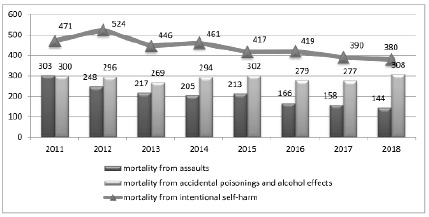
Fig. 1. Mortality from some external causes in the Kyrgyz Republic (absolute numbers)
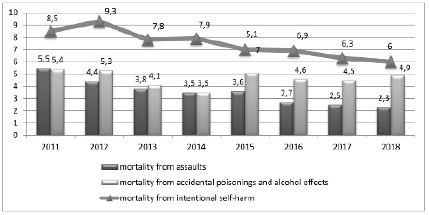
Fig. 2. Mortality from some external causes in the Kyrgyz Republic (per 100 000 population)

Fig. 3. Poverty level of the population by budgets based on a sample survey of households (%)
According to literary sources, 40% of deaths due to suicide in the world occur in low- and middle-income countries. There is recognition of the fact that social factors, such as socio-economic status, play an important role in determining suicide risk in high-income countries as well [1, 2]. The analysis of the poverty level (% of the total population) in the republic for 2011-2018 showed that during this period an increase in the number of people below the poverty level was recorded in 2011-2013 with the maximum number (38%) in 2012. A less significant increase in this indicator (32.1%) was noted in 2016 (Fig.3).
Since the change in the diet is an additional indicator of the socio-economic situation [3], we also analyzed the ratio of proteins, fats and carbohydrates in the diet of the population according to a sample study of households (Fig.4). It turned out that the deterioration of the economic situation in 2012 and 2016 is confirmed by a change in the diet: in 2012 and 2017, the population consumed a minimum amount of protein (58.8 g and 58.5 g, respectively), but the decrease in caloric content of food in 2017 is partially offset by higher fat intake (58.9 g in 2012 and 61.8 g in 2017). Thus, in the analyzed period of 2011-2018, there are two intervals of deterioration of the economic situation in the republic, confirmed by changes in the diet of the population: 2011-2012 and, to a lesser extent, 2016-2017.
Studies conducted in various countries have shown that the decline in living standards is the main reason for the increase in both the general morbidity and the incidence of alcoholism, especially alcoholic psychoses, which in turn are risk factors for suicidal behavior. The improvement of the socio-economic situation contributes to the stabilization of the epidemiologic situation of alcoholism [4, 5].
We analyzed the dynamics of the incidence of drug addiction and substance abuse, as well as the dynamics of alcoholism and alcoholic psychoses diagnosed for the first time in life (Fig.5).

Fig. 4. Nutritional value of food according to a sample survey of households (in grams)
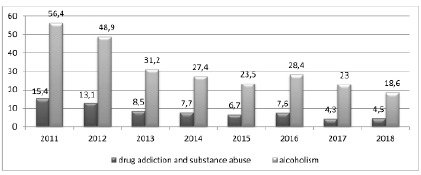
Fig. 5. Incidence of newly diagnosed alcoholism, drug addiction and substance abuse in the Kyrgyz Republic (per 100 000 population)

Fig. 6. Incidence of newly diagnosed mental and behavior disorders in children aged 0-14 years and adolescents 15-17 years in the Kyrgyz Republic (per 1000 population of the corresponding age)
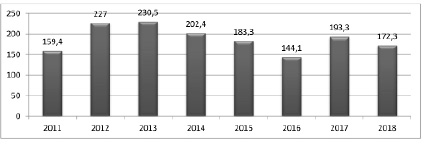
Fig. 7. Incidence of newly diagnosed mental and behavioral disorders in persons aged over 18 years (adults) in the Kyrgyz Republic (per 1000 000 population)
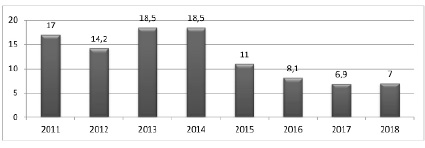
Fig. 8. Incidence of newly diagnosed syphilis in the Kyrgyz Republic (per 100 000 population)
As can be seen from the figure, in the period from 2011 to 2016 there is a persistent downward trend in their incidence. In 2016, there was an increase in the number of newly diagnosed cases of these pathologies, then again a steady decrease in their frequency.
One of the powerful determinants of alcoholization and narcomanization of society, bearing the risk of forming suicidal behavior in a part of people, is the socio-economic crisis and poverty of the population [6-8].
Analysis of the incidence of mental disorders and behavioral disorders in various age groups (children 0-14 years old, adolescents 15-17 years old, adults over 18 years old) showed that the change in the number of people newly diagnosed with these pathologies occurs synchronously across these age groups.
As can be seen from Fig. 6, the maximum number of newly diagnosed mental disorders and behavioral disorders in both children aged 0-14 years and adolescents aged 15-17 years was recorded in 2014. In persons over 18 years of age, an increase in the morbidity was noted in 2013, and, to a lesser extent, in 2017 (Fig. 7).
The pathology reflecting the social situation in society is sexually transmitted diseases. Unfavorable socio-economic living conditions may be accompanied by an increase in morbidity and manifest themselves in an increase in the number of people with newly diagnosed syphilis, gonorrhea, trichomoniasis, gardnerellosis, chlamydia, etc.
As an example, we have considered the dynamics of the incidence of syphilis in the population of the republic (per 100,000 population). As can be seen from the diagram, the highest incidence of syphilis was recorded in 2013-2014 (18.5/100,000). Since 2015, there has been a persistent trend towards a decrease in the incidence (Fig.8).
We calculated the Spearman correlation coefficient between the economic situation in the republic (poverty rate in %) and mortality from intentional self-harm, which showed a statistically significant relationship: rs=0.827, p<0.05. There is a statistically significant relationship between alcoholism and alcoholic psychoses and mortality from intentional self-harm (rs = 0.833, p<0.05), as well as between the incidence of drug addiction and substance abuse and mortality from intentional self-harm (rs = 0.929 p<0.01). Thus, a statistically significant association of some parameters of the external environment and mortality from intentional self-harm was revealed.
Conclusion
Summing up the results of this study, we can conclude that the maximum number of deaths from intentional self-harm (524 people, 9.3/100,000) in the republic was recorded in 2012, and a detailed analysis by region showed that there is a “wave-like” spread of this process: in regions with predominant rural population, the higher the proportion of rural residents in the region the later the peak number of completed suicides occurs. The assessment of the economic condition of the population of the republic showed that the years 2012 and 2016-2017 were economically difficult. During these years, the maximum level of poverty of the population was noted, the quality of nutrition decreased as shown by assessments in a sample survey of households. Since 2013, the total number of people with a primary diagnosis of drug addiction has been growing, which is an additional aggravating factor in the formation of suicidal behavior. 2012 and 2013 are characterized by an increase in the number of adults over the age of 18 who were newly diagnosed with mental disorders and behavioral disorders, in children under 14 years of age and 15-17 years old adolescents, the maximum incidence was noted in 2014. In the same time intervals, an increase in the incidence of STDs (syphilis) was noted, the health of newborns worsened.
Thus, there is a set of interrelated factors, against which an increase in the number of suicides is registered. Consequently, the phenomena occurring in the republic are systemic in nature, as indicated by the relationship of socio-economic indicators and some indicators of the health status and mortality of the population.

